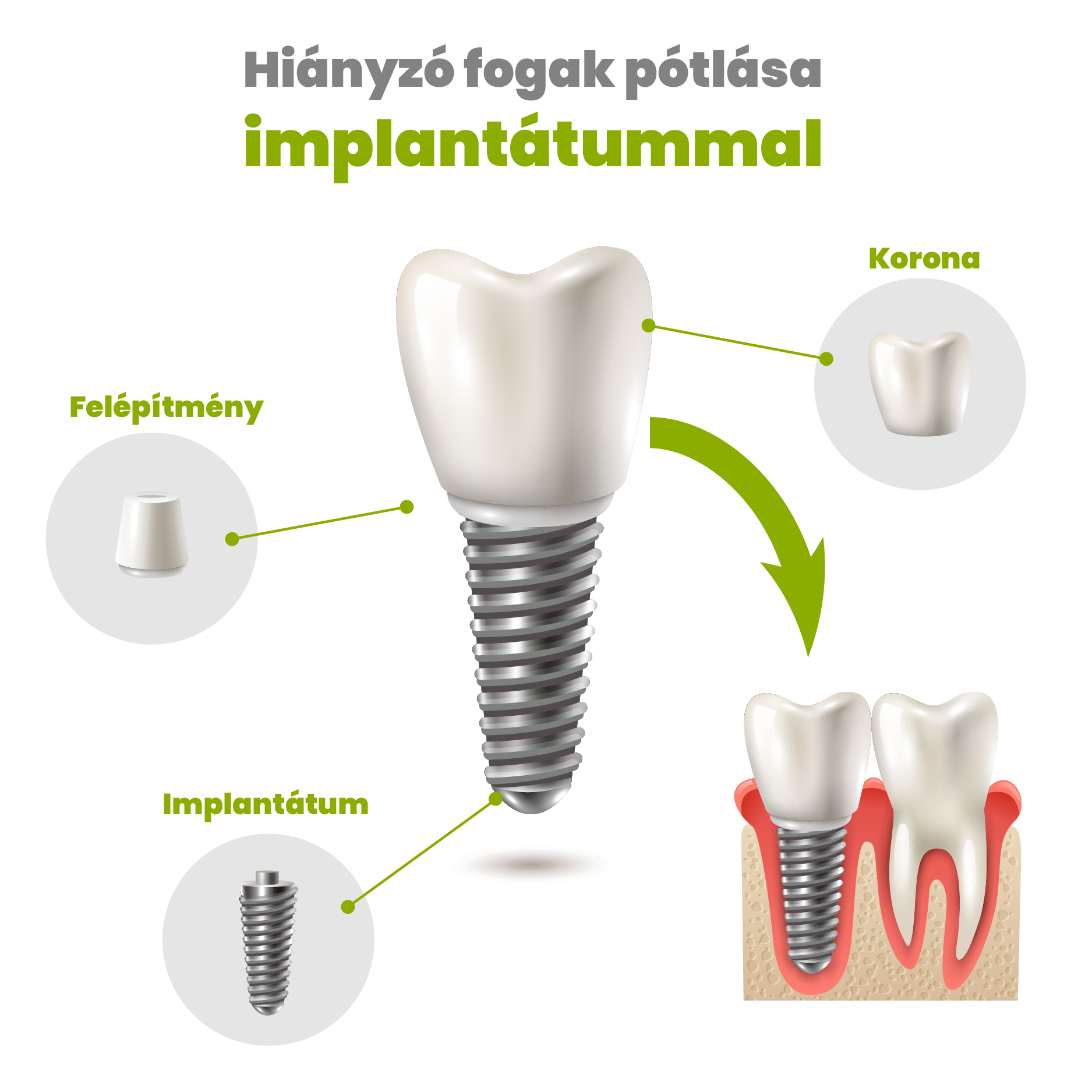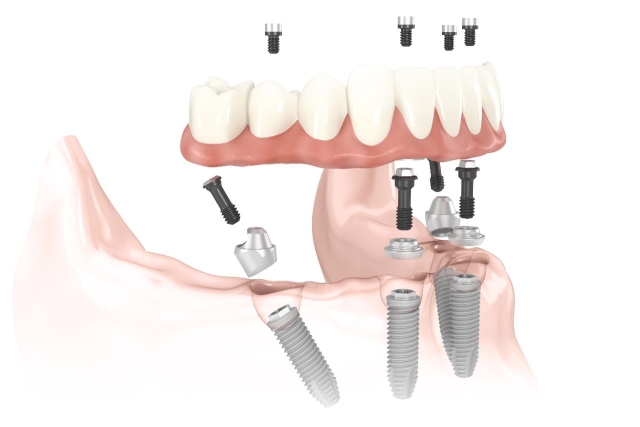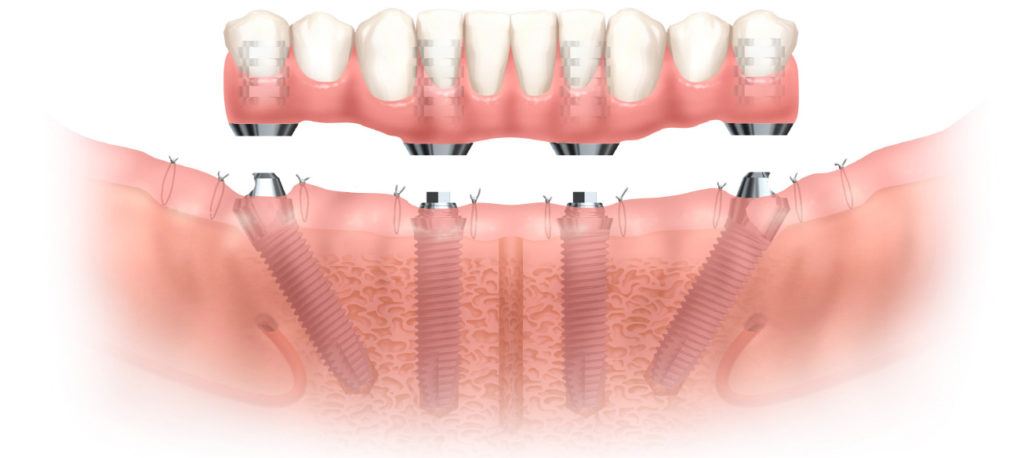Implants
Achieve the perfect smile with the most up-to-date and professional solution for missing teeth!
Missing teeth can be a source of many issues in your day-to-day life. Besides aesthetic problems, you might face other consequences that negatively effect your overall health. Healthy teeth next to missing teeth are more prone to getting cavities, this quickly gets to the roots and results in the need of a root canal treatment. In addition, they might start to drift out of their healthy position due to the lack of support and protection. On the long run, this leads to a high level of instability and the deterioration of alveolar bones.
What is an implant?
An implant is an artificial root that is used for replacing the root of the missing tooth. It is placed under the gum, into the jawbone by a simple surgery, under local anesthesia. After the healing period, which is approximately takes 4-6 months, a connecting abutment and a crown is placed on top.
The implant forms a biological connection with the surrounding bones, this makes it an utterly stable base for a crown, a bridge or even a complete denture.


What are the main advantages of implantation?
LONG-LASTING
As long as maintaining a sufficient care of the implant, it should last an entire lifetime.
INTACT HEALTHY TEETH
One of the biggest advantages of implantation is that there is no need for your healthy teeth to be involved in the process, meaning we are able to preserve them perfectly in their normal state.
SAFE
The most used implant material is a metal called titanium. It is completely hypoallergenic and does not cause any malignancy in the human body.
NATURAL
The crown placed on the healed implant is remarkably natural and healthy-looking, making it closely resemble our natural teeth.
ALL-ON-4® Implants


The ALL-ON-4® technology is currently the most modern procedure in the field of implantology. The expression itself refers to all teeth being supported on four dental implants, per jawbone. This innovative technique provides a great solution for people with more missing teeth, even in case of complete toothlessness, to completely secure both upper and lower jaw area.
One of the biggest advantages of this technique is that the dentures are affixed to the implants at a special angle, which means that the implantation can be performed without sinus elevation or bone replacement surgery. Moreover, the extraction of remaining teeth, the implantation itself and the insertion of temporary bridge are all carried out in one session.
All of these factors contribute to reduced healing time, optimised overall cost, gaining confidence and comfort in a shorter amount of time.
Implants significantly prevents the deterioration of alveolar bones and helps to slow down the process of face aging.
Implantation is a great solution for:
- Gaining confidence when it comes to eating and smiling
- Preserving the health of your teeth for as long as possible
- Investing in a lifelong treatment
REPLACEMENT OF TEETH NEEDED FOR FURTHER RESTORATIONS
Fixed restorations require a lot of support, this could succesfully be provided using dental implants.
REPLACING ONE MISSING TOOTH
In case of one missing tooth there is no in need for the preparation of healthy teeth adjacent to missing teeth, meaning we are able to preserve them in their healthy state for as long as possible.
IN CASE OF COMPLETE TOOTHLESSNESS
Dental provide an excellent and stable base for even a complete denture, gaining a long-lasting, & secure solution.
Is it painful?
Plenty of patients are often concerned about the pain that comes with implantation. Based on the feedback of previous patients who received implants, the amount of pain is far below than you would expect, thanks to modern anesthetic techniques. For some patients, treatment under sedation is the best and most appealing offer. It involves breathing in a mixture of N2O2 and O2 that results in a relaxed state, while remaining conscious at all times and will experience no discomfort or pain.
Following the implantation, little after the surgery, you might experience slight discomfort and sensitivity. It is totally normal and can be treated with painkillers based on your doctor’s intructions.

What are the main steps of implantation?
In most cases, tooth extraction and implantation can be carried out in one session, followed by a temporary crown or bridge. These temporary restorations work and function just like your normal teeth, this allows us to minimise your discomfort and inconviniences.
IMPLANT
Under local anesthesia, the implant is inserted into the bone through the gum. After this, the gums are closed again over the implant by stitches. The suture has to be removed after about a week. In most cases, temporary crowns or bridges are placed on top immediately.
TAKING THE IMPRESSION AND CONSTRUCTION OF FINAL CROWN/BRIDGE
After 4-6 months of healing time, the healing screw is exchanged for an abutment, followed by impression-taking. Based on this, our dental technician uses the latest CAD/CAM technology to construct the final restoration.
INSERTION AND FITTING OF FINAL CROWN/BRIDGE
Az elkészült fogpótlást a behelyezett implantátumra ültetjük rá legtöbb esetben csavarozással, néha ragasztással.
References



